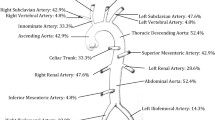Abstract
The aim of this was to assess clinical features and outcome in pediatric-onset Takayasu’s arteritis (TA). Retrospective data analysis of patients diagnosed with TA over last 13 years with onset before 18 years of age was done. Their presenting features, activity (by NIH criteria, ITAS2010, ITAS-A), disease extent (by DEI.Tak) and angiographic findings were retrieved from clinic files. Treatment received and follow-up data on disease activity and damage by TA damage score (TADS) were also analyzed. Wherever repeated angiography data were available, the same was analyzed. Values are expressed as median with interquartile range in brackets. There were 29 patients (19 females) with median age at diagnosis of 14 (13–16) years and delay to diagnosis of 1 (0.4–2) year. Common presenting symptoms were pulse loss (23/29) and hypertension (22/29). Patients had extensive disease at presentation with median DEI.Tak of 12 (9.5–15); 23/29 had elevated acute-phase reactants, and 28/29 were active at presentation [median ITAS2010 13 (8–15.5), ITAS-A 14 (10–17)]. Numano’s type V was the commonest angiographic type (22/29). At a median follow-up of 2.4 (1.5–5.1) years, 2/20 were active whereas all had sustained damage despite a majority (17/20) being on immunosuppression. The median TADS was 8 (6.3–9.8) with pulse loss, claudication and hypertension being the commonest damage item. Two needed renal artery stenting to control hypertension. Angiographic assessment at least 2 years apart demonstrated disease progression in 5 of 6 patients despite immunosuppression. Significant damage accrued on follow-up despite immunosuppression and control of disease activity. Hypertension remains the major long-term morbidity.

Similar content being viewed by others
References
Weyand CM, Goronzy JJ (2003) Medium-and large-vessel vasculitis. N Engl J Med 349:160–169
Zheng DY, Liu LS, Fan DJ (1990) Clinical studies in 500 patients with aortoarteritis. Chin Med J 103:536–540
Weiss PF (2012) Pediatric vasculitis. Pediatr Clin North Am 59:407–423
Muranjan MN, Bavdekar SB, More V, Deshmukh H, Tripathi M, Vaswani R (2000) Study of Takayasu’s arteritis in children: clinical profile and management. J Postgrad Med 46:3–8
Jain S, Sharma N, Singh S, Bali HK, Kumar L, Sharma BK (2000) Takayasu arteritis in children and young indians. Int J Cardiol 75(Suppl 1):S153–S157
Cakar N, Yalcinkaya F, Duzova A et al (2008) Takayasu arteritis in children. J Rheumatol 35:913–919
Jales-Neto LH, Levy-Neto M, Bonfa E, de Carvalho JF, Pereira RM (2010) Juvenile-onset Takayasu arteritis: peculiar vascular involvement and more refractory disease. Scand J Rheumatol 39:506–510
Zhu WH, Shen LG, Neubauer H (2010) Clinical characteristics, interdisciplinary treatment and follow-up of 14 children with Takayasu arteritis. World J Pediatr 6:342–347
Goel R, Kumar TS, Danda D et al (2014) Childhood-onset Takayasu arteritis—experience from a tertiary care center in South India. J Rheumatol 41:1183–1189
Szugye HS, Zeft AS, Spalding SJ (2014) Takayasu arteritis in the pediatric population: a contemporary United States-based single center cohort. Pediatr Rheumatol Online J 12:21
Clemente G, Hilario MO, Lederman H et al (2014) Takayasu arteritis in a Brazilian multicenter study: children with a longer diagnosis delay than adolescents. Clin Exp Rheumatol 32(3 Suppl 82):S128–S133
Brunner J, Feldman BM, Tyrrell PN et al (2010) Takayasu arteritis in children and adolescents. Rheumatology 49:1806–1814
Ozen S, Pistorio A, Iusan SM et al (2010) EULAR/PRINTO/PRES criteria for Henoch–Schonlein purpura, childhood polyarteritis nodosa, childhood Wegener granulomatosis and childhood Takayasu arteritis: ankara 2008. Part II: final classification criteria. Ann Rheum Dis 69:798–806
Aydin SZ, Yilmaz N, Akar S et al (2010) Assessment of disease activity and progression in Takayasu’s arteritis with disease extent index-Takayasu. Rheumatology 49:1889–1893
Kerr GS, Hallahan CW, Giordano J et al (1994) Takayasu arteritis. Ann Intern Med 120:919–929
Misra R, Danda D, Rajappa SM et al (2013) Development and initial validation of the Indian Takayasu clinical activity score (ITAS2010). Rheumatology 52:1795–1801
Aydin SZ, Merkel PA, Direskeneli H (2015) Outcome measures for Takayasu’s arteritis. Curr Opin Rheumatol 27:32–37
Hata A, Noda M, Moriwaki R, Numano F (1996) Angiographic findings of Takayasu arteritis: new classification. Int J Cardiol 54(Suppl):S155–S163
Arnaud L, Haroche J, Limal N et al (2010) Takayasu arteritis in France: a single-center retrospective study of 82 cases comparing white, North African, and black patients. Medicine 89:1–17
Vanoli M, Daina E, Salvarani C et al (2005) Takayasu’s arteritis: a study of 104 Italian patients. Arthritis Rheum 53:100–107
Morales E, Pineda C, Martinez-Lavin M (1991) Takayasu’s arteritis in children. J Rheumatol 18:1081–1084
Raj M, Krishnakumar R (2013) Hypertension in children and adolescents: epidemiology and pathogenesis. Indian J Pediatr 80(Suppl 1):S71–S76
Corbetta JP, Duran V, Burek C et al (2011) Renal autotransplantation for the treatment of renovascular hypertension in the pediatric population. J Pediatr Urol 7:378–382
Kim SY, Park JH, Chung JW et al (2007) Follow-up CT evaluation of the mural changes in active Takayasu arteritis. Korean J Radiol 8:286–294
Tso E, Flamm SD, White RD, Schvartzman PR, Mascha E, Hoffman GS (2002) Takayasu arteritis: utility and limitations of magnetic resonance imaging in diagnosis and treatment. Arthritis Rheum 46:1634–1642
Clifford A, Hoffman GS (2014) Recent advances in the medical management of Takayasu arteritis: an update on use of biologic therapies. Curr Opin Rheumatol 26:7–15
Prasad S, Misra R, Agarwal V, Lawrence A, Aggarwal A (2013) Juvenile dermatomyositis at a tertiary care hospital: is there any change in the last decade? Int J Rheum Dis 16:556–560
Dhir V, Aggarwal A, Lawrence A, Agarwal V, Misra R (2012) Long-term outcome of lupus nephritis in Asian Indians. Arthritis Care Res 64:713–720
Conflict of interest
None.
Author information
Authors and Affiliations
Corresponding author
Rights and permissions
About this article
Cite this article
Misra, D.P., Aggarwal, A., Lawrence, A. et al. Pediatric-onset Takayasu’s arteritis: clinical features and short-term outcome. Rheumatol Int 35, 1701–1706 (2015). https://doi.org/10.1007/s00296-015-3272-7
Received:
Accepted:
Published:
Issue Date:
DOI: https://doi.org/10.1007/s00296-015-3272-7




